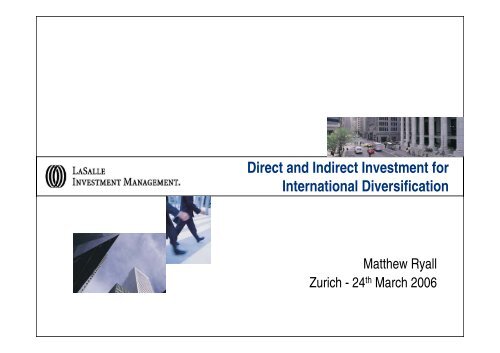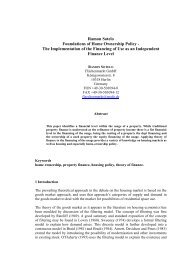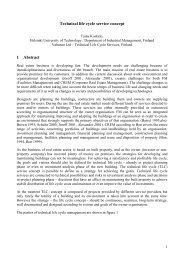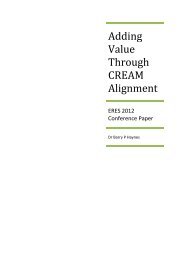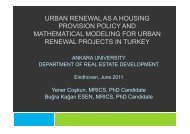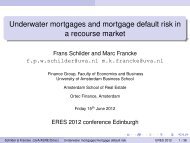Direct and Indirect Investment for International Diversification
Direct and Indirect Investment for International Diversification
Direct and Indirect Investment for International Diversification
You also want an ePaper? Increase the reach of your titles
YUMPU automatically turns print PDFs into web optimized ePapers that Google loves.
<strong>Direct</strong> <strong>and</strong> <strong>Indirect</strong> <strong>Investment</strong> <strong>for</strong><br />
<strong>International</strong> <strong>Diversification</strong><br />
Matthew Ryall<br />
Zurich - 24 th March 2006
Agenda<br />
• The need <strong>for</strong> cross border diversification<br />
• The diversification challenge<br />
• How to diversify direct / indirect
Traditional Institutional Property <strong>Investment</strong><br />
• Home region/country<br />
• Offices<br />
• Act as a portfolio diversifier <strong>for</strong> <strong>International</strong> equities/bonds<br />
“Cross border investment has traditionally been a mistake”
Why cross border<br />
• Higher returns<br />
• <strong>Diversification</strong><br />
• Safe haven<br />
• Lack of domestic opportunity<br />
• Matching liabilities<br />
• Environmental / Altitude
IPD Returns<br />
UK<br />
Portugal<br />
Spain<br />
France<br />
Irel<strong>and</strong><br />
IPD Europe<br />
Norway<br />
Netherl<strong>and</strong><br />
Denmark<br />
Finl<strong>and</strong><br />
Switzerl<strong>and</strong><br />
Sweden<br />
Germany<br />
Source: IPD Europe<br />
0 2 4 6 8 10 12 14<br />
Total Return pa (% ) Local currency<br />
UK<br />
Portugal<br />
Spain<br />
France<br />
I l d
Greater Choice : Major European Cities by GVA<br />
Rotterdam<br />
Edinburgh<br />
Birmingham<br />
London<br />
Leeds<br />
Manchester<br />
Zurich<br />
Geneva<br />
Stockholm<br />
Lisbon<br />
Warsaw<br />
Oslo<br />
Utrecht<br />
Glasgow Brussels<br />
Frankfurt<br />
Stuttgart<br />
Munich<br />
Berlin<br />
Hamburg<br />
Düsseldorf<br />
Copenhagen<br />
Madrid<br />
Amsterdam<br />
Barcelona<br />
Rome<br />
Bologna<br />
Valencia<br />
Seville<br />
Helsinki<br />
Milan<br />
Turin<br />
Dublin<br />
Budapest<br />
Paris<br />
Lyon<br />
Marseille<br />
Bordeaux<br />
Lille
Property <strong>Investment</strong> : Increasingly Cross Border<br />
$bn<br />
600<br />
500<br />
400<br />
300<br />
200<br />
North America<br />
Europe<br />
North America<br />
Domestic<br />
100<br />
0<br />
2003 2004 2005<br />
Source: Jones Lang LaSalle
Challenges<br />
• Finding trustworthy local partners/operators<br />
• Currency <strong>and</strong> political risk<br />
• Tax drag (in some markets)<br />
• Many countries have lower transparency<br />
• Lack of global benchmarks (except securities)<br />
• Communicating across time zones <strong>and</strong> cultures<br />
• Volatility of returns<br />
Cross-border real estate can compensate investors <strong>for</strong> these costs <strong>and</strong> risks
How to invest globally <strong>for</strong> diversification<br />
Take a step-by-step approach to international:<br />
1. Tax<br />
2. Fund of Funds / <strong>International</strong> global real estate securities<br />
3. Add private, indirect funds<br />
4. Add JVs <strong>and</strong> partnerships in transparent markets<br />
5. The ultimate goal is NOT a direct cross-border portfolio of buildings<br />
6. Put real estate into a currency overlay program
Global framework: style criteria <strong>for</strong> selecting markets<br />
<strong>International</strong><br />
Objective<br />
Target<br />
Return<br />
Fundamentals<br />
Relative Importance<br />
Capital<br />
Market Gap Transparency<br />
<strong>Diversification</strong><br />
Costs<br />
(Tax, currency<br />
& legal)<br />
Core<br />
6% - 9%<br />
Value Added<br />
10% - 15%<br />
Opportunistic 15%+<br />
Source: LaSalle <strong>Investment</strong> Management
<strong>Direct</strong> vs. <strong>Indirect</strong>
The UK Property Market Universe<br />
Listed<br />
AIM<br />
Pooled<br />
Property<br />
Funds<br />
Listed<br />
Offshore<br />
<strong>Direct</strong><br />
Private<br />
Funds<br />
Derivatives<br />
Source: LaSalle <strong>Investment</strong> Management
Property Risk/Return profile<br />
Volatility of returns<br />
over benchmark<br />
<strong>Direct</strong> Asset<br />
REITs<br />
Specialist Funds<br />
Balanced Funds<br />
Property Derivatives<br />
Potential return over the benchmark<br />
Source: LaSalle <strong>Investment</strong> Management
Past Per<strong>for</strong>mance – Alternative <strong>for</strong>ms of Real Estate<br />
100.00%<br />
80.00%<br />
60.00%<br />
40.00%<br />
20.00%<br />
0.00%<br />
-20.00%<br />
1990<br />
1991<br />
1992<br />
1993<br />
1994<br />
1995<br />
1996<br />
1997<br />
1998<br />
1999<br />
2000<br />
2001<br />
2002<br />
2003<br />
2004<br />
2005<br />
-40.00%<br />
Balanced Funds Index FTSE Real Estate Index <strong>Direct</strong> Property IPD
Option 1: <strong>Direct</strong> property ownership<br />
Products<br />
• Domestic<br />
• Collection of national portfolios<br />
• Regional portfolios<br />
• Global portfolio<br />
Positives<br />
• Maximum diversification benefits<br />
• Maximise control<br />
• National benchmarks<br />
Negatives<br />
• Scale, specific risk / portfolio size<br />
• No global or regional benchmarks<br />
• Low liquidity<br />
• Management<br />
• Administration<br />
• Tax <strong>and</strong> legal
Option 2: Unlisted/private indirect property funds<br />
Global funds<br />
• <strong>Investment</strong> banks<br />
• Opportunistic<br />
• Highly leveraged<br />
• No control over regional weights<br />
Targeted funds<br />
• Specialist managers/<br />
<strong>Investment</strong> banks<br />
• Open or closed end<br />
• Sector/country/regions<br />
• Varying risk profiles<br />
• Availability<br />
JVs/ Clubs<br />
• Specialist managers<br />
• Usually closed end<br />
• Varying risk profiles<br />
Positives<br />
Negatives<br />
• <strong>Diversification</strong> retained<br />
• Utilise expert management<br />
• Private equity model<br />
• Low liquidity <strong>and</strong> control<br />
• Lack of benchmarks<br />
• Global funds rarely<br />
balanced by region<br />
Fund of funds or individual investments
Option 3: Listed/public property company securities<br />
“REITs”<br />
Conventional listed corporations<br />
Real Estate <strong>Investment</strong> Trusts<br />
• Property owning vehicle<br />
• Lower dividend yield<br />
• Distributes 80% - 100% of taxable income<br />
• High dividend yield<br />
• Limited ability to generate reserves <strong>for</strong> investment<br />
• Country opportunities<br />
‣ North America – US <strong>and</strong> Canada<br />
‣Europe – Belgium, Netherl<strong>and</strong>s, France, shortly UK<br />
<strong>and</strong> Germany<br />
‣Australasia – Australia, Singapore, Japan, Hong Kong<br />
• Higher correlation with general equities<br />
Positives<br />
• Established benchmarks<br />
• Liquidity<br />
• Transparency<br />
• <strong>Investment</strong> period: immediate<br />
Negatives<br />
• Influence of general equity markets<br />
• Relatively immature market in some<br />
countries
Australia<br />
China<br />
Benchmark Weightings<br />
60%<br />
50%<br />
40%<br />
30%<br />
20%<br />
10%<br />
0%<br />
US<br />
Canada<br />
Mexico<br />
Brazil<br />
Germany<br />
France<br />
Italy<br />
Spain<br />
Netherl<strong>and</strong>s<br />
Sweden<br />
UK<br />
Switzerl<strong>and</strong><br />
Japan<br />
GDP Listed Real Estate
Correlation of Global Asset Class Returns<br />
Correlation of Total Returns (1986-2004), US Dollar<br />
Global Stocks<br />
Global Bonds<br />
Global <strong>Indirect</strong><br />
Real Estate<br />
Global <strong>Direct</strong><br />
Real Estate<br />
Global Stocks 1.00<br />
Global Bonds 0.19 1.00<br />
Global <strong>Indirect</strong> Real Estate 0.47 0.30 1.00<br />
Global <strong>Direct</strong> Real Estate 0.10 -0.35 0.15 1.00<br />
Sources: GPR Index, UBS Global Property Investors Index; MSCI Global Equity, JP Morgan Global Bond Index, LaSalle <strong>Investment</strong> Management
Switching Model – <strong>Indirect</strong> or <strong>Direct</strong><br />
4.0<br />
3.0<br />
IPD EY less 5-year Swap Rate (%)<br />
2.0<br />
1.0<br />
0.0<br />
-1.0<br />
-2.0<br />
-3.0<br />
-4.0<br />
-5.0<br />
<strong>Direct</strong> market to outper<strong>for</strong>m<br />
over following 12 months<br />
<strong>Indirect</strong> market to outper<strong>for</strong>m<br />
over following 12 months<br />
Point of indifference<br />
Oct-03 to Sept-04<br />
Oct-02 to Sept-03<br />
Oct-01 to Sept-02<br />
-6.0<br />
-6.5 -5.5 -4.5 -3.5 -2.5 -1.5<br />
FTSE Real Estate DY less IPD EY (%)<br />
Sources: Datastream, IPD
Option 4: Derivatives<br />
“Available” today<br />
• <strong>Direct</strong> Property – UK <strong>and</strong> US only<br />
• Property equities- ETF’s on<br />
EPRA/NAREIT<br />
Positives<br />
• Quick/easy/cheap to trade<br />
• Instantaneous exposure<br />
• Price transparency<br />
• Strategic or tactical use<br />
Negatives<br />
• Currently small size/ limited supply<br />
• Very limited coverage of property markets<br />
• No guarantee of roll-over<br />
• Negative per<strong>for</strong>mance relative to market after costs
Cost of Currency: Swiss Example<br />
Investors’ gain/loss of investing abroad (capital only) per annum<br />
Country of <strong>Investment</strong><br />
/ Number of Years<br />
1<br />
3<br />
5<br />
10<br />
15<br />
Eurol<strong>and</strong><br />
0.2%<br />
-0.4%<br />
0.8%<br />
0.4%<br />
1.0%<br />
USA<br />
-11.3%<br />
-9.3%<br />
-3.6%<br />
-0.2%<br />
-1.9%<br />
UK<br />
-2.9%<br />
1.6%<br />
1.3%<br />
-1.4%<br />
1.0%<br />
Source: LaSalle <strong>Investment</strong> Management; DataStream. As at 25th August 2004.
Conclusion: <strong>Direct</strong> <strong>and</strong> <strong>Indirect</strong><br />
SIZE OF FUND<br />
Derivatives<br />
Balanced Funds<br />
REITs / Fund of Funds<br />
Domestic Portfolio - <strong>Direct</strong><br />
<strong>Direct</strong><br />
Assets<br />
Specialist Funds<br />
CROSS BORDER PROPORTION
Cross-border investing – the Swiss perspective<br />
• Switzerl<strong>and</strong> has an important real estate market but returns have<br />
been low<br />
• Investors can enhance returns as well as enjoy diversification<br />
benefits by going cross-border<br />
• Real estate securities are a low risk option <strong>for</strong> diversified global<br />
exposure<br />
• Consider:<br />
– Opportunistic – Asia<br />
– Value-add – Canada, US, France<br />
– Core – global securities, UK, Germany, Netherl<strong>and</strong>s <strong>and</strong> Sweden


